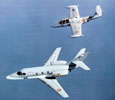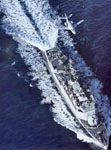
TRANSPORT AND TRAINING AIRCRAFT
|
HISTORY |
|
Development In order to compete
with the Learjet and De Havilland DH 125, both considered at that
time as the most efficient jets worldwide, Dassault launched a
study for a smaller version of their Falcon 20, based on experience
gained with the MD.320 Hirondelle (swallow) prototype. |
|
Falcon 10 MERs of the l'Aéronautique Navale (since 1975)

|
|
At the beginning of the seventies, the French navy went in search of a plane to perform various duties like military and political VIP transport, training missions on behalf of ships at sea, including calibration, radar, simulation of enemy planes, target detection and acquisition, radar and IFR training for student pilots. The navy consequently ordered six Garrett TFE 73I equipped aircrafts, designated Falcon 10A Marine. These received a specific treatment preventing sea-induced corrosion. In 1973, a seventh plane (N°185) had to be delivered to replace N°39 which crashed in Toul, on January 30th, 1980. |
In section
|
In spring 1975, the
SRL (Section Réacteur de Landivisiau - Landivisiau's Jet
Engine Department), took delivery of two Falcon 10 MER (Marine
Entraînement Radar - Navy Radar Training) to complete its
fleet of MS.760
Paris. |
|
Every single operational
FFAA pilot has to fly at least once on a SRL Falcon 10, be it
for IFR training or to validate their qualifications. |
|
Year |
Falcon 10's allotment to the S.R.L. |
Year |
Falcon 10's allotment to the S.R.L. |
|
1975 |
2 aircraft |
1979 |
3 aircraft |
|
1976 |
2 aircraft (No32 and 39) |
1980 |
4 aircraft |
|
1977 |
2 aircraft (No32 and 39) |
1981 |
3 aircraft |
|
1978 |
2 aircraft |
|
|
In 1978, the 3.S squadron,
based at N.A.S.
Hyères - Var, took delivery of its first Falcon 10.
Its missions were basically identical to that of the SRL: calibration,
training, liaison, evacuation, support and so on. |
In 1981, the 57.S
also based at N.A.S. Landivisiau succeeded to the S.R.L. It provides
the same missions with the same aircraft (Falcon and Paris). In 1978,
the Falcon 10 MER were retrofitted with the Agave Radar, the exact same
model that equiped the Super-Étendard,
the brand new fighter that was progressively being delivered to Navy
operational squadrons. This ensured a seamless transition for training
fighter pilots. In 1997, flight 57.S received three Falcon 10 from flight
3.S, thus becoming the sole user of the Falcon 10 MER in the entire
French navy.
On Wednesday, November 15th, 2006 at 5:30 pm at NAS Landivisiau, under
the presidency of Admiral Rostolan commanding officer of French Naval
Aviation took place the ceremony of introduction into forces of Falcon
10 MER Standard 2. The standard 2 upgrade consisted in putting in the
standards " OACI " (organization of the international civil
aviation) of all the avionics of Falcon 10 so that this plane, entered
service in 1975 within the squadron 57.S can adapt itself to the continuous
growth of the requirements of the civil air traffic in equipments and
in instrumentation. Falcon 10 is daily integrated into the civil air
traffic in conformance with its missions of qualification in the flight
without visibility of the jet pilots of naval aviation and communicatin/
liaison of very high authorities of Marine. This upgrade led by DFS
(Dassault Falcon Service, subsidiary of Dassault Aviation, manufacturer
of the aircraft) lasts 2 years and should concern in the years to come
five other Falcon 10 of the Navy, all in service within the squadron
57. S
|
FALCON 10 MERs OF THE AÉRONAUTIQUE NAVALE |
|
Number |
Delivery |
Convoying |
|
32 |
April 15th 1975 |
May 5th 1975 |
|
39 |
June 27th 1975 |
June 27th 1975 |
|
101 |
February 28th 1978 |
March 2nd 1978 |
|
129 |
April 2nd 1979 |
April 2nd 1979 |
|
133 |
July 4th 1979 |
July 4th 1979 |
|
143 |
April 15th 1980 |
April 15th 1980 |
|
185 |
January 24th 1983 |
January 24th 1983 |
|
|
|
|
|
|
|
|
|
|
|
|
|
|
|
|
|
|
|
|
|
|
|
|
|
|
|
|
|
|
|
|
sources - acknowledgements :
"Avion Marins" Luc Berger - Dassault Aviation
- 1998.
Avion de Combat du Monde - Éditions Atlas.
Air Fan N°280 (mars 2002).
Jets N°54 (juin 2000) et 55 (juillet 2000)
"Les commandements de l'Aéronautique
Navale (1912-2000)" ; Major Norbert Desgouttes ; ARDHAN - 2001
©French Fleet Air Arm. www.ffaa.net. All rights reserved.



